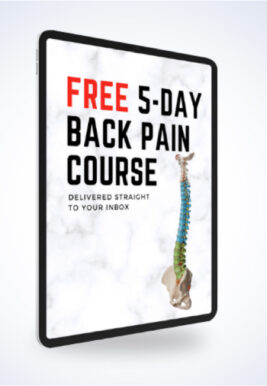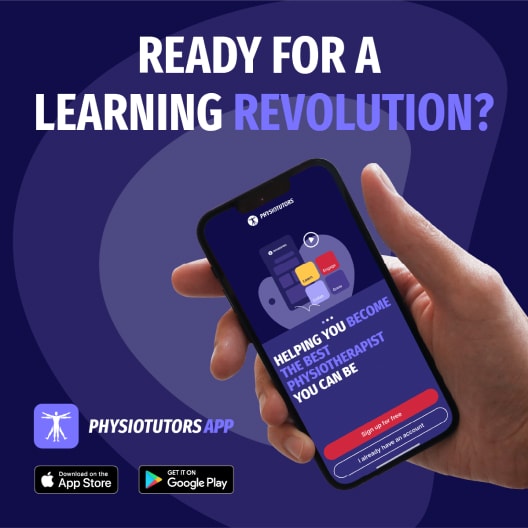Thoracolumbar Syndrome | Diagnosis & Treatment

Thoracolumbar Syndrome | Diagnosis & Treatment
Introduction & Pathophysiology
Patient’s who present with low back pain, but also ipsilateral gluteal and groin pain may be experiencing referred pain from spinal nociception from the thoracolumbar junction, abbreviated as TLJ. Robert Maigne first described thoracolumbar syndrome in 1974, which is why this syndrome is commonly known as Maigne’s syndrome.
Pathomechanism
The TLJ may be more susceptible to biomechanical disturbance due to lower stability compared to the thoracic spine as the last two ribs not being attached to the sternum. Furthermore, it is an area where the alignment of the facet joints changes from the frontal plane in the thoracic facets to the Sagittal plane in the lumbar facets. This transitional position might make the TLJ more susceptible to overload.
The pathomechanism is similar to that of lumbar facet syndrome. Irritation of the facet joints and/or articular capsule and/or excessive paraspinal muscle tone may cause irritation of neural structures and produce clinical symptoms.
These neural structures are the dorsal rami, but also the ventral rami of the lower thoracic and upper lumbar nerve roots from T11 to L2.
Follow a course
- Learn from wherever, whenever, and at your own pace
- Interactive online courses from an award-winning team
- CEU/CPD accreditation in the Netherlands, Belgium, US & UK
Clinical Picture & Examination
Next to tenderness upon palpation and pressure of the TLJ, irritation of the dorsal rami in the TLJ area can refer pain to the unilateral iliac crest and upper gluteal region. Irritation of the ventral rami of the TLJ region can lead to unilateral pseudovisceral pain in the hypogastric area, false sciatic neuralgia, tenderness of the pubic symphysis, and hypersensitivity of the intestines.

Pain is triggered by extension and/or rotation and does not cross the body’s midline as the nociceptive structures are only innervated unilaterally.
Examination
Be aware that Maigne’s syndrome is a rather rare clinical pattern. It is therefore advisable to first exclude the lower lumbar spine, the SI joint, and the hip as the responsible areas of nociception. The following orthopedic tests or test batteries are recommended to exclude these areas:
- A quick screening test for all 3 regions: Menell Test
- Sacroiliac Joint: Cluster of Laslett
- Hip Joint: FADDIR Test
- Lumbar Spine: PIVMS in prone position
Next to tenderness of palpation of the TLJ, the iliac crest should be palpated for tenderness. Move 7 centimeters laterally from the midline and rub the crest in an up-and-down motion on the posterior iliac crest point. This should elicit sharp pain as the irritated cutaneous branches of T11-L1 are compressed.

Maigne suggests comparing the sensitivity difference on the iliac crest, the inguinal canal, or the greater trochanter by rolling and tightening the skin on both sides. In the Kibler Fold Test, the examiner raises a fold of skin between the thumb and forefinger and rolls it along the trunk perpendicular to the course of dermatomes. The patient should experience more tenderness and hyperesthesia on the affected side compared to the healthy one.

At last, it has to be mentioned that TLJ syndrome is diagnosed clinically as most radiological studies will be normal and false positive results are common. Only a diagnostic nerve block in which the affected facet joint is injected with local anesthesia is described to be useful to confirm the hypothesis.
Free 5-Day Back Pain Email Course

Follow a course
- Learn from wherever, whenever, and at your own pace
- Interactive online courses from an award-winning team
- CEU/CPD accreditation in the Netherlands, Belgium, US & UK
Treatment
Originally, Maigne proposed manipulative therapy for the TLJ region. Furthermore, Alptekin et al. (2017) showed that steroid injections and exercise were able to decrease pain. No hard recommendations can be given at this point as hard evidence is rather scarce.
The following thoracic mobilization exercises might be a treatment option:
References
Follow a course
- Learn from wherever, whenever, and at your own pace
- Interactive online courses from an award-winning team
- CEU/CPD accreditation in the Netherlands, Belgium, US & UK
How to Master Treating Spinal Conditions in Just 40 Hours


What customers have to say about this online course
- Ybe Boesveld17/06/25Erg informatieve cursus Vorig jaar opleiding manueel afgerond en deze cursus sluit goed aan op het niveau hiervan. veel artikelen weer op kunnen halen. Zeker aan te bevelen!Martijn17/06/25Duidelijke cursus Mooie, leuke en duidelijke cursus. Enige nadeel vond ik soms de vertaling van engels naar nederlands. Voor de rest was dit een hele fijne cursus om online te doen!
- Luis Humberto dos Santos Soares16/04/25Orthopedic Physiotherapy of the Spine "Clear and practical explanations — my knowledge has been seriously upgraded! Helped me pass my course with confidence."Michel Veerman16/04/25Top Super cursus. Alles mooi op een rijtje gezet over de wervelkolom.
- Orkun Buyukyilmaz06/04/25Take every course on physiotutors! This knowledge will make you a more relaxed physio. Because you know more!Ruud31/03/25orthopedische fysiotherapie van de wervelkolom top cursus, goed om alles weer even op te frissen.
- Robin28/03/25Top Cursus Perfecte cursus om je kennis op te frissen. Informatie is Straight to the point, aangevuld met handige video's.Emre Keskin02/01/25Very good cursus! Thanks to this course, I am more confident to examine and treat patients with spine-related complaints. It was a good refresher for me.
- Bas31/12/24Leerzame cursus Een hele fijne en leerzame cursus waarbij mijn kennis is uitgebreid door de behandelde stof. Zeer tevreden en aan te raden aan andere collega'sAlex Pluijmert30/12/24The Spine Ideal course to get your facts strait on the latest evidence.
- Tom Wellens29/12/24Orthopedic physiotherapy of the spine Zeer uitgebreide en duidelijke cursus.
Goed om het geheugen nogmaals op te frissen. Aanrader voor iedereen die werkt met patiënten met wervelkolom gerelateerde klachten!Jaime van der Lugt27/12/24Orthopedics Physiotherapy of the Spine Well organised and clear set-up course to refresh and to learn new things around the spine. Would definitely recommend it! - Erik Plandsoen26/12/24Cursus: 'The spine' Fijne opfrissingscursus en met momenten zeker ook vernieuwend. Voor mij als fysiotherapeut soms het gevoel dat de mobilisatietechnieken vooral Manueel therapie gericht waren, maar daarom niet minder leerzaam!Rud Raymakers24/12/24Course the Spine Fijne cursus! Overzichtelijk en leerzaam en goed recap na MT opleiding!
- Salih Kuzal23/12/24Cursus The Spine De cursus was zeer behulpzaam voor mijn vaardigheden en handelingen om mijn patienten effectiever te behandelen.
Ik vond het ook heel leuk en leerzaam om het uit te voeren.Steffie van der Niet22/12/24Orthopedic Physiotherapy of the spine Ook voor ervaren therapeuten een leerzame Online course, waarbij soms wat heilige huisjes van fysiotherapie uit de "oude" tijd omver geschopt worden. - Stefan Verbruggen17/12/24Cursus Goed opgezette cursus met een quiz aan het eind van elke onderdeel.
Heel overzichtelijk en leerzaam.Jordy17/12/24Valuable and well-organized I am very satisfied with this course. The setup was clear and well-structured, making the material easy to follow. The videos were helpful and of good quality, with clear explanations that really helped in understanding the content better. The combination of theory and practical examples ensured that the information is directly applicable. All in all, it is a valuable and well-organized course that I would definitely recommend to others! - Todd A. Baker15/12/24Thorough and comprehensive course Well executed and organized course.Roland Zwiggelaar08/12/24Nice learning course I found this course very good because it updates my total knowledge of the spine.Also it shows you the info with the latest articles there are for now.



